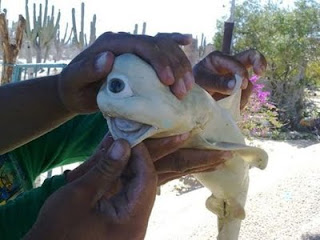A fisherman has discovered the Cyclops shark this reports of something strange. This mysterious creature named albino fetal shark with one eye smack in the middle of its nose like a Cyclops.
But the Cyclops shark was sliced from the belly of a pregnant mama dusky shark caught by a profit-making fisherman in the Gulf of California earlier this summer, is by all reports the real thing. Shark researchers have examined the preserved creature and found that its single eye is made of functional optical tissue.

It's unlikely, however, that the malformed creature would have lived outside the womb."This is extremely rare," shark expert Felipe Galvan Magana of Mexico's Centro Interdisciplinario de Ciencias del Mar told the Pisces Fleet Sport fishing blog.”As far as I know, less than 50 examples of an abnormality like this have been recorded”.
The Cyclops shark is unexpected. While rare, "cyclopia" is a real developmental anomaly in which only one eye develops. Human fetuses are sometimes affected, as in a 1982 case in Israel reported in 1985 in the British Journal of Ophthalmology.



